From the catalogue "NANA SHIOMI", 2003
Introduction
I started painting in oils at the age of fourteen, and soon developed an interest in contemporary art when I attended a seminar on Marcel Duchamp at Tama Art University, Tokyo. The concepts of Duchamp’s work such as- “art can be multiple”, “art can be ready-made”, “art and language” and “art as performance”, seemed to me to be the very essence of contemporary art. I was profoundly attracted to pop artists such as Andy Warhol and Jasper Jones. And at the age of 20, I grew interested in the concept of “hanga” (prints). A prerequisite of prints is the fact that “plate and print” are always opposite configurations. I soon encountered dualistic principles everywhere, such as- “right and left”, “top and bottom”, “East and West”, “man and woman” and so on. It is no mere coincidence that since then most of my work is composed of two opposing sides, right and left. I also instinctively chose to work in water-based woodcuts. The fact that I chose the traditional woodcut technique- using the “baren” to spread the water-based ink and let it soak into the Japanese paper- as the means with which to communicate my intent was an integral element in determining my style.
| 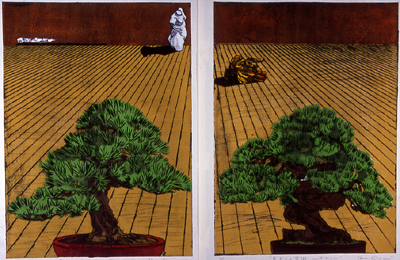
|
|
Art on Art
I feel there is more than enough art accumulated over the ages. My interest lies not in outwardly expressing my personal and sentimental views but presenting my own view of things while drawing upon, or quoting, existing art. All the time-weathered fragments that survived and are referred to today as "art" have historical significance, and each and every one is a symbol with a beautiful form that is indelibly imprinted on our mind's eye. I reorganize those symbols in my own style, rearrange them according to my fancy or concept and hope that the viewer will sense a“viewpoint”, a way of seeing things that hopefully is new and unique. Since coming to the United Kingdom in 1989, and living in a land not my own, I am constantly forced to think about issues relating to my own identity, and in recent years have grown more aware of my own roots.
| 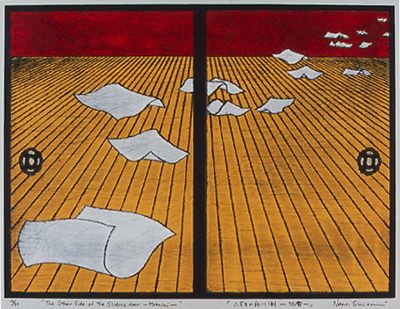
|
|
One Hundred Views of MITATE
One of the many differences that I find interesting between the West and Orient, is the view of the universe itself. In the West, the universe is seen in a vertical configuration, with human beings in the centre, God above, and animals below, and with plants lower still. However, in the Japanese viewpoint, humans animals, insects, plants, minerals, the elements, wind and rain, the moon and other planets are juxtaposed, so that the whole world, including the self, are equality, there is a ready feeling of empathy and a natural feeling of oneness with the rest of the universe.
For the MITATE series, I selected 100 elements that I consider profoundly relevant to Japanese culture. All the elements are juxtaposed equally. Each of these selected elements is closely intertwined with the lives of the Japanese people, referred to from antiquity in songs, stories, poems and dances, drawn on paper, made into pastry, used as decorations and as patterns on kimono fabric.
MITATE refers to a process of thought that Japanese culture has enjoyed since ancient times, a form of analogy comparing one thing to another. The white sand and rock formations in a Japanese garden, for example, are in reality nothing more than sand and rocks, but enjoying the free association the viewer can see in them such images as “island in the sea”, or “the universe and the self” or so on. Objects become more than single elements when repositioned in their total context, and their relationships can then be seen in a new light. In the MITATE series, my objective is to have the viewer choose any of the 100 elements that take their fancy and give them new meaning by creating their own combinations and associations. This viewer selection then, will give new life to and take on new meanings for the worn-out and antiquated symbols of Japanese culture.
| 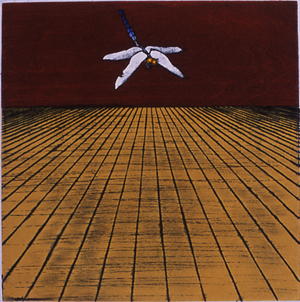
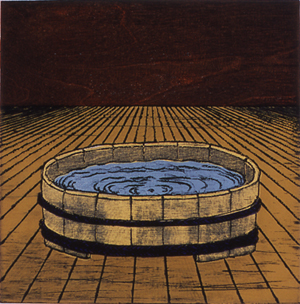
|
|
HAGAKURE- Hidden Among Leaves
Hagakure is a memorandum of warrior mores for the Japanese samurai written in the 18th century by Yamamoto Tsunetomo. It is both a philosophical and practical guide on how to live one's life. It is filled with detailed do's and don'ts, but what struck me most was the dictum "true love endures". To love someone from a distance for a lifetime and to die of longing, that is the quintessential love according to Tsunetomo's teachings. This did not refer to the warrior's love for his woman, but to the love between teacher and disciple, between comrades, namely fraternal love. The author considers spiritual love without physical satisfaction, akin to self-sacrifice, the ultimate kind of love.
Also, since ancient times the Japanese have an empathy for insects, projecting the image of the self as a lowly speck in the universe. With the influence of Shintoism, the Japanese came to naturally accept the concept of reincarnation. Some people think that they might become an insect in a future life. In my print: I quote from Hokusai's “Iris and Grasshopper”.
| 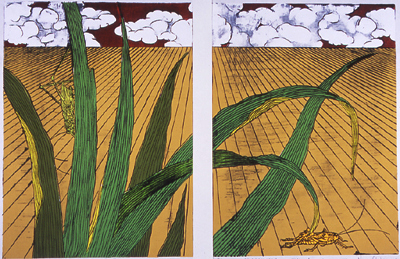
|
|
Here or There - Bridge -
Connecting two distant points, a bridge has many more meaning than its practical significance. In Japan, as in many other countries around the world, the bridge is both seminal and symbolic. It has not only been a recurring and important theme in mythology, folklore, poetry and drama but appears frequently in Japanese names and designs, and has been an integral part of people's daily lives. The two points separated by the bridge may be more than simply two locations. They could sometimes mean “dream and reality” or at other times be :this world and the next, and the bridge that connects the two points is hallowed ground bordering both everything illusory and everything real, signifying the entrance to the other world.
After I turned forty, death seemed to take on a familiarity I had not felt before. The work “Here or There, -BRIDGE-”created at the same time as “Here or There, -BOAT-” tries to give material form to that which connects life and death. The bridge then is that which connects the world we live in with the world after death. There is in all probability a Buddhist view of the world behind this concept, but I think that the question of “this shore, the other shore” is for most peoples something rather primal, beyond individual religious beliefs. Noh drama always begins with the departed crossing a bridge to appear before the living. A characteristic of Japanese culture, I feel, is a relative freedom of movement, a nonchalance about the boundary between the “world after death” and the presently lived in “real world”.
| 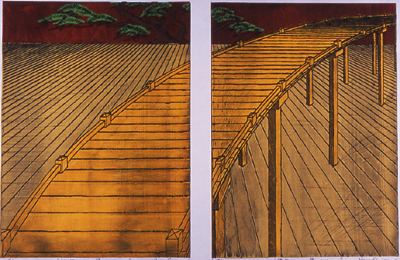
|
|
On HOKUSAI
HOKUSAI , born in 1760, was a representative artist of the Edo period, but I believe he was at the same time a great thinker whose ideas would be valid today. The elements in the universe he depicts are singular and created with a unique viewpoint; they also have a sense of the cinematic and dynamic. The “36 Views of Fugaku”, which actually shows 46 views of mount Fuji, is especially famous, but I cannot help thinking that the series is a set of self portraits. As one’s vantage point changes so the view of the mountain will also change. Likewise the state of the existence of one human being changes with each passing moment and is truly multi-faceted. This seems to me to be the message, a celebration of human existence.
In “HOKUSAI’S WAVE (Right top) -Happy Dog-” and “HOKUSAI’S WAVE (Right bottom) -Happy Carp-” face right and left. These images are about the vortex and strength of living things.
|
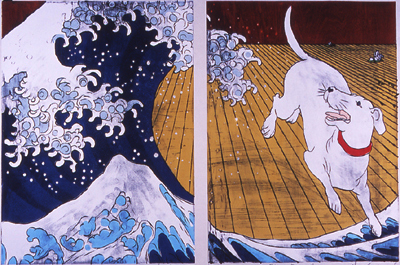
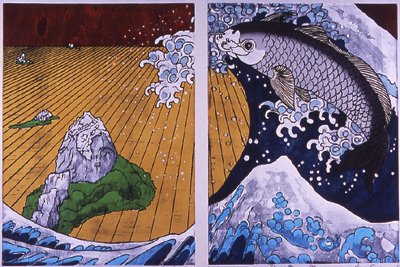
|
|
A Room on the Other Shore
If the picture frame is something like a window frame hung on the wall then a painting could be considered a landscape that stretches inside the frame. The black frames used in this series are the frames used for “fusuma” the Japanese sliding doors. The “fusuma” partition a room, and function very much as doors do. They are frequently embellished with landscapes that represent changing seasons. In this series I followed convention and depicted an open door over a closed one. There is a room beyond the door, through the window, or through the bamboo blind, through which one can see the river and ocean. Further still is an island and trees, signifying the existence of a different world. The scene on the surface of the “fusuma”continues to explain itself, going deeper, and still deeper. What is the other shore ? What lies beyond the painting, on the other side of the door ? Is it possible, that this side on which we live is indeed the other side ? The “other shore” in Buddhist terminology means the state of enlightenment, as well as the world of the dead.
|
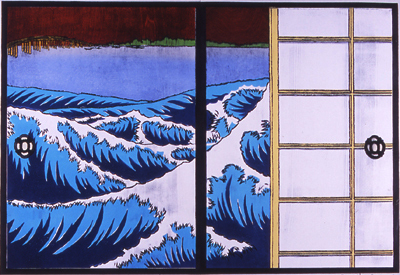
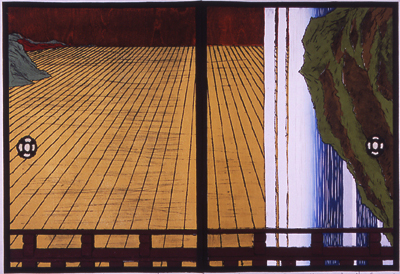
|
|
In Closing
None of us can choose a period in history in which to be born. Those of us born and living in the latter half of the 20th century will accept the period in which we live, be embraced by the times, and will eventually depart. Each and every one of us exists as a wheel, moving the times ahead, and as a mirror of the times. In front of me looms a mountain of innumerable symbols, works of art that my predecessors left behind. I find joy in how I, as a mirror, as an artist, can hopefully reflect some of those symbols, and share the reflections with many other peoples.
|
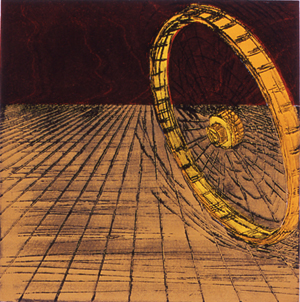
|
|
From Artist's Eye, 'Printmaking Today' Winter issue 2006
“ MIRROR ROOM - Katsura - ”
I am neither a painter nor a sculptor, but a full-time printmaker. For me, this is a statement that possesses great significance. For me, to merely paint a picture without going through the process of creating a plate with which to print it feels like an act both sentimental and dangerously ungrounded. Every profession bestows on its practitioners a way of looking at things, an outlook on life, and my profession of printmaking is no different. It is first and foremost as a printmaker that I see the world, and it is as a printmaker that I attempt to grasp its ways.
My approach might be described technically as combination relief/intaglio water-based woodcut printmaking. It is rooted in the traditional methods of Japanese ukiyoewoodblock printmaking, to which I have added my own experiments with new techniques and new materials. The fundamental ukiyoemethod involves the application of water-based inks to individually carved colour relief blocks, and then the rubbing of the ink into the fibres of washi(Japanese paper) with a handheld printing pad known as a baren. My innovations have included the application of varnish to the blocks, the smearing of acrylic paints into carved and scratched intaglio blocks, and the vigorous removal of the inks with a squeegee. Combinations of these techniques, tried and tested old ones and uncertain new ones are the fundamental elements that have determined the grammar of my work. I believe that to talk of my techniques is to talk of my philosophy of life, just as to talk of my patterns of thought is to talk of my printmaking techniques.
As an inevitable consequence of the nature of printmaking, thediametrical opposites of theplate and the print are welded together in a single, unbreakable schema. For many years I have been fascinated by all kinds of dyadic systems: left and right, back and front, east and west, female and male.The mirror image is the original; without one the other cannot exist. This is deep stuff! Many of my works are constructed around a left panel and a right panel, and this too has its roots in these same ideas.
1. When drawing an object on tracing paper love the process (the pursuit of beauty!) of sharpening and polishing the silhouette of the object to be depicted.
2. love the indirectness (so similar to divine possession) of printmaking, where nothing is painted directly, where everything is created through the plate.
3. love the multiple nature of printing (its modern rationality and egalitarianism).
4. love the repeated movements that printing requires (the simple repetition that gives form to my everyday life).
5. love the honesty of the plates where one impression will never be better or worse than its predecessor (a just reward indeed).
6. love the gap between my initial vision (in Buddhist terms, my earthly desires) and the end result (destiny).
In these ways, for me to think about printmaking is the same as thinking about the ways of the world. This is the gift that printmaking has bestowed upon me. I honestly believe that all I know about the mysteries of life, I have learnt through my plates and prints.
“MIRROR ROOM - Katsura - ” is my attempt at a visual representation of the mysterious bond between plate and print. This is not the first time I have used a mirror image in my work, but by using an interior as the motif rather than a specific object, the eye has more freedom to move within the image. The minimal construction of space in a traditional Japanese room is ideal for depicting the labyrinthine relationship between plate and print. A picture is an illusion created by paint applied to the surface of a sheet of paper. A single, stripped surface that opens up in front of the viewer. Just as the boy in the picture never ages, so too people can never see what lies beyond the sliding screens in my print. Still, surely the artist should be able to hint at the past and future of the boy in the picture. So too can I provide hints for the viewers of what is hidden beyond the screens, of the landscape that opens up behind the screens. In the years to come I will continue to bend to my plates, as though peering into a mirror - in order to capture that which comes from beyond the mirror’s surface.
|

|
|
From the catalogue "Looking into the Mirror Pond " 2010
I am neither a painter nor a sculptor, but a printmaker.
For me this is a statement. Every profession bestows on its practitioners a way of looking at things, an outlook on life.
I honestly believe that all I know about the mysteries of life,
I have learnt through my plates and prints.
National, International
Filled with a desire to learn more about the world, I left my native Japan and came to live in the UK. But as I struggled towards my goal of becoming an international artist, I began to realize that if I were to embody internationalism in its truest sense, I must first understand my own national background. In other words, I needed to cast aside my own point of view and re-examine myself from the perspective of the other. It is not the quickest path to take, but I still believe it is the most reliable one. I discovered that it was only by traveling half way around the world to another country and through living there as a foreigner, that I could find the well I must dig.
|

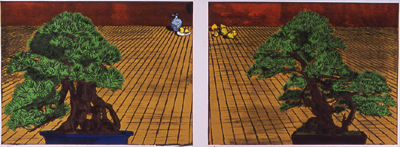
|
|
This Side and the Other Side
If the picture frame is something like a window frame hung on the wall then a painting could be considered a landscape that stretches inside the frame. The black frames used in this series are the frames used for ‘fusuma’, Japanese sliding doors. The ‘fusuma’ partition a room, and function very much as doors do. They are frequently embellished with landscapes that represent the changing seasons. In this series I followed convention and depicted an open door over a closed one. There is a room beyond the door, through the window, or through the bamboo blind, through which one can see the river and ocean. Further still is an island and trees, signifying the existence of a different world. The scene on the surface of the ‘fusuma’ continues to reveal itself, going deeper, and still deeper. What is the other shore? What lies beyond the painting, on the other side of the door? Is it possible, that this side on which we live is indeed the other side? The ‘other shore’ in Buddhist terminology means the state of enlightenment, as well as the world of the dead.
|

|
|
Minimalism and Japanese Culture
When I look back at Japan’s traditional culture, what astonishes me most is its modernity. The communicative potential of its simple symbolic systems, the sense of play evident in the way it created portable objects, the rationality of its use of space pushed to a minimalist extreme, the way it discards the superfluous and just hones the essential... In each of these qualities I perceive the spirit of the craftsman. It might sound strange but I believe that I learned the nature of the contemporary through Japanese traditional culture.
Japanese houses are constructed using natural materials. When we enter into a building with tatami mats, we take off our footwear. Windows are made wide and full-length, with semi-transparent reed blinds and paper-covered panels used to separate internal from external space. The size of rooms can be flexibly adjusted using sliding doors and standing screens. When I think of the tokonoma, the tearoom and so on, these aspects of Japanese daily life let us glimpse our view of nature, our sense of beauty, our religious identity and spirituality. No matter what changes the future may bring, the Japanese will continue to take off their shoes when entering a house.
|

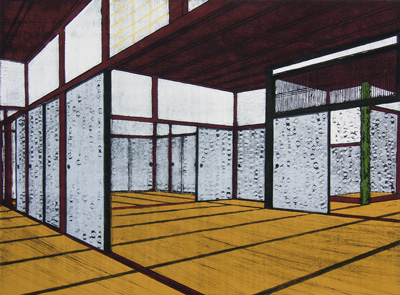
|
|
The Surging Waves and Myself
The multiple nature of the print medium is its strongest quality, not its weakest. Each print is not unique, but every print is an original. Therefore if you look closely enough, you will see that each print is also slightly different. The light and dark, the shading, the blurring of individual lines - these minute differences that I want you to fall in love with. “7th May 1956, 8th May 1956” is a vertically arranged diptych printed from the same blocks, in exactly the same way. The repeating motions of the waves, rising and falling day after day... Within that eternal repetition, one day we are born, another day we are gone. The world and myself. All I want to do with my work is to grasp for a second the world’s tail.
|
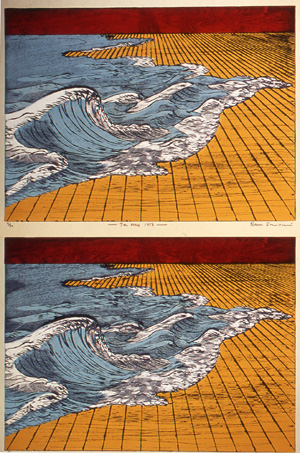
|
|
The World’s Right and the World’s Left
You can create an entirely different landscape from these two prints, depending on whether you join them A-B or B-A. In addition, I designed them so that you could join these prints to the left or right of them in a never-ending sequence A-B-A-B-A-B-A-B...... I envisage adding one to another until they encircle the globe and I can finally join the last B to the very first A, creating a vast looped landscape. Whether you choose to journey clockwise or anticlockwise is up to you.
|


|
|
How to Draw Emptiness
People create pictures because they want to depict something. But what if we want to depict emptiness? Would it be possible to use a picture to explain emptiness? “Neither Cherry Blossoms nor Autumn Leaves” is my response to that question. A pair of objects placed on an empty stage - a standing screen painted with a picture of an empty stage. The title is borrowed from a poem by the 12th century poet Fujiwara no Teika.
|
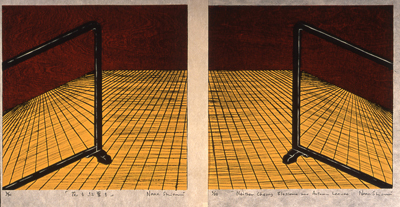
|
|
The Man Who Changed My Life
We cannot choose when or where we will be born. The time and the place in which you find yourself is determined almost entirely randomly, but for each individual that reality comprises their life. For me, it was chance that determined that I should come across an artwork by Marcel Duchamp when I was twenty - but that chance meeting was to have a decisive influence over my later life. Duchamp taught me that creating a piece of art is an act that has far more value and meaning than I had ever expected. He also taught me the importance of continuing to give yourself stimulating problems to solve. And the importance of continuing to search for an answer. And these are the most enjoyable things in life!
|

|
|
The Story of 凸 and 凹
The same staircase looks different depending on whether you are standing at the top looking down or at the bottom looking up. The way you understand a particular event is always dependent upon your point of view. And conversely, the way that someone explains their take on a particular fact will always reveal their position to you. Is a woodblock carved in relief or intaglio? Everything that happens to me forces me to clarify my own standpoint.
|
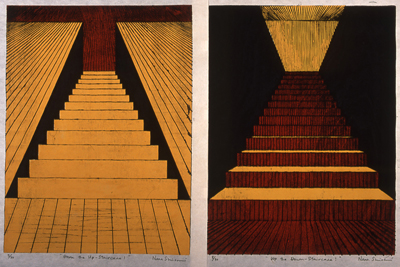
|
|
Something Lying Between Illusion and Reality
From ancient times, in both east and west, mirrors have been accorded a literary and philosophical significance that outweighs their practical usage. In stories such as that of Narcissus, or the mirror within Velázquez’s painting Las Meninas, or Alice Through the Looking Glass, mirrors have been depicted as having the power to affect human psychology. In Japan too, mirrors are seen as being able to capture the shining brightness of the sun and thus are used as objects of veneration in Shinto. Or we can think of the Golden Pavilion (Kinkakuji) in Kyoto, which is always described as being one of Japan’s most beautiful buildings - but if it had not been built next to a ‘mirror pond’ (Kyoko-ike), would it have been able to attain the same reputation for beauty? A certain power resides in the mirrored image. The connection between the real Golden Pavilion and its image mirrored in the pond is the same as that between a woodblock and a printed image produced from it. Reality and its reflection. Form and image. What lurks in the border between the block and the print? Is it will... or action... or the divine itself?
|
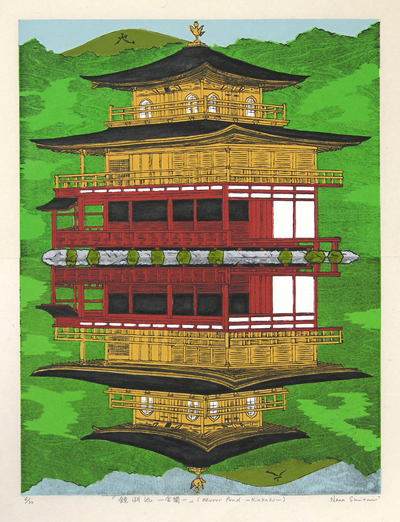
|
|
From Exhibition Statement "Reverse: Universe" 2014
|
|
|
Filled with a desire to learn more about the world, I left my native Japan and came to live in the UK. But as I struggled towards my goal of becoming an international artist, I began to realize that if I truly wanted to embody internationalism, I must first understand my own national background. In other words, I needed to cast aside my own point of view and re-examine myself from the perspective of the other. It is not the quickest path to take, but I still believe it is the most reliable one. I discovered that it was only by travelling half way around the world to another country and through living here as a foreigner, that I could find the well I must dig.
There is a Japanese idiom, “Gyaku mo mata, shin nari,” which means something like vice versa, or “the converse is also true”. I find much to agree with in this idiom. Truth is never singular. The truth’s opposite may also be true. The way you understand a particular event is always dependent upon your point of view. And conversely, someone’s explanation of their take on some particular fact will always reveal their perspective. For me, this understanding of reality is hugely important. We cannot find the ‘true’ truth when we adopt a one-sided viewpoint. Rather, we must also consider the opposite viewpoint. Through my work, I want to show how any integrally formed truth has both a front and rear. I am very proud to say that the medium of printmaking is the perfect vehicle for communicating this truth.
One of the prerequisites of printmaking is the fact the plate and the print always exist in opposing configurations. Everywhere I look I seem to encounter similar dualistic principles: left and right, front and back, up and down, East and West, male and female. As a printmaker I have become addicted to thinking about these dualisms. It is no mere coincidence that a large proportion of my work is comprised of two opposing sides, right and left.
Why do I make prints? My answer is that I feel that in the process of printmaking and in the prints that result from that process there is something hugely important to be discovered, something even worth staking my life on. I have always felt that some important clue to understanding the processes and secrets of this world is hidden there. As a single human being, realistically there is very little that I can contribute, yet still, every day as I turn to face my prints I cannot help but feel that I am about to discover some universal truth. It sounds absurd, I know. But I believe that everyone who has been gifted with life in this world has felt something similar, even if they do not put it into words.
Take a fisherman for example. He sets out to see in the morning. The weather is very changeable. Whether he will catch lots of fish or not depends partly on experience, partly on luck. He must feel joy when his catch is good. He thanks nature and the gods. He reflects on his errors, he looks forward to tomorrow. He learns from each day. I believe that he feels something similar to me, something universal. Whether you are a dancer, a banker, an astronaut, if you apply yourself to your labour, I believe that you will discover some truth. That’s why I make prints. Because I feel there is a great truth waiting to be discovered there. There are fascinating worlds to discovered everywhere if you dig deep enough.
At the end of the printing process, when I peel the paper from my last block, I feel a thrill. I become the first viewer of my work. I designed the work, but on first viewing, there is always something surprising. As a medium, printmaking never permits precise results. I cut the blocks and put the colours on the plates, but I cannot insert myself between the plate and the paper. This indirect automation is one of the beauties of printmaking.
When I have a gallery show, I get to meet my work in a public space. This is a special experience indeed. I become my own critic. I might not have a real critic’s facility with words, but I can still grasp in an instant whether a work has succeeded or failed. I don’t know what the audience thinks about my work. I don’t care how they read my concepts, or if they managed to find their own meanings, or if they felt nothing. But, if the work inspires you to stop and think for a moment, then I am delighted.
|
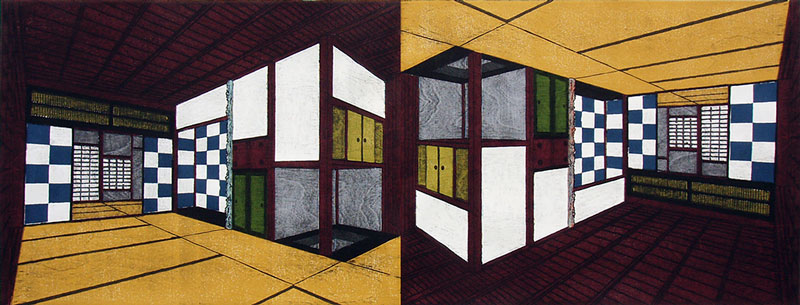
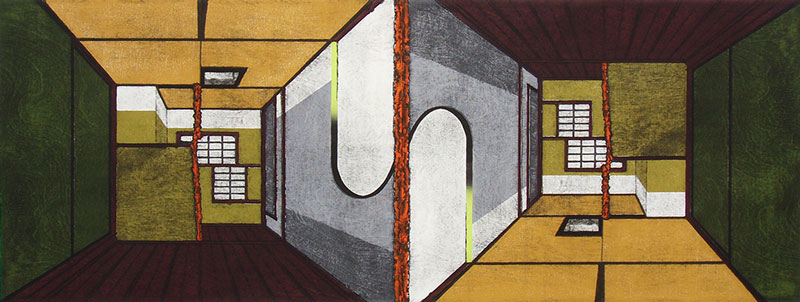
|